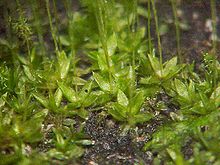|
Funaria
Funaria is a genus of approximately 210 species of moss. Funaria hygrometrica is the most common species. Funaria hygrometrica is called “cord moss” because of the twisted seta which is very hygroscopic and untwists when moist. The name is derived from the Latin word “funis”, meaning "a rope". In funaria root like structures called rhizoids are present.[2] Capsules are abundant with the moss surviving as spore when conditions are not suitable. Moss plant Funaria grows in dense patches or cushions in moist shady and cool places on rocks, walls or crevices during the rainy seasons. It has a height of 3–5 cm, a radial symmetry with a differentiation of an axis or stem, leaves or phylloids are multicellular colorless branched rhizoids with oblique septa. These are primitive multicellular, autotrophic, shade loving, amphibious plants. They reproduce by spore formation. They have no vascular system. Root like structures called rhizoids are present. They show alternation of generation i.e. the gametophytic stage alternates with the sporophytic stage. External structure of gametophytePlant body is gametophytic and consists of two stages: juvenile and adult. The juvenile stage is represented by "primary protonema" (thread-like structures formed directly by spore germination). The adult stage is represented by leafy gametophore which is differentiated into rhizoids, axis and leaves. Rhizoids arise from the base of the axis and they are slender, branched, obliquely septate and provides anchorage for the bryophyte. The axis is a stem-like structure arising from the rhizoid, long, slender, monopodially branched. The each branch is extra axilliary arising form the base of a leaf. The leaves are sessile, oblong-ovate with entire margin and pointed apex. Each leaf is transversed by a mid rib. Leaves are born spirally around the axis. MorphologyThe adult plant body is foliose gametophyte which is leafy and branched which is differentiated into axis, leaves, rhizoids. Axis/Stem: Small, erect, upright, slender, monopodially branched Leaves: Spirally arranged around the axis. Flat, green with a well-defined mid-rib. Lower leaves are smaller and scattered and upper leaves are large and crowded. Rhizoids: Basal, branched, multicellular, obliquely septated mainly for absorption of minerals and anchorage to substratum. T.S. of axisDivided into 3 regions:
T.S of leafThe transverse section of the leaf shows a well-defined mid-rib with two lateral wings except in the mid-rib region. There are single-layered parenchymatous polygonal cells with prominent chloroplasts. The central part of the mid-rib has a narrow conducting strand of thick walled cells that helps in conduction. Accepted species
References
|
||||||||||||||||||||||||||||
Portal di Ensiklopedia Dunia
